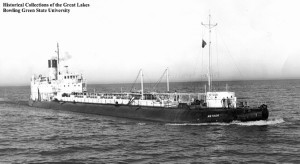Behold the Mighty Meteor!
by wjw on August 5, 2015
 Behold the SS Meteor, at 119 years old the sole surviving whaleback freighter, and now in Superior, WI, moored in, um, mud apparently. (I actually took these pictures a couple weeks ago, but haven’t got around to looking at them till now.)
Behold the SS Meteor, at 119 years old the sole surviving whaleback freighter, and now in Superior, WI, moored in, um, mud apparently. (I actually took these pictures a couple weeks ago, but haven’t got around to looking at them till now.)
My interest in anachronistic technology led me to view this glorious Victorian creation, which actually served on the Great Lakes from 1896 until 1969.
The whaleback ships were invented by uncanny Gaelic engineer Alexander MacDougal, who built them on his own account because he couldn’t get financing for something this radical. The whalebacks are built along the lines of a submarine, which got invented around the same time, and had only a couple feet of freeboard while fully loaded. Here’s a view of the Meteor in action.

The great advantage of the whalebacks was their utter stability in a heavy sea. The disadvantages were the fact that they rode so low in the water that other, bigger ships tended not to see them, and rode them down. A number were lost in collisions.
Also, there was a limit to their size. They couldn’t get above 500 feet, because the unconventional hull structure wasn’t strong enough to support its own weight at greater lengths, and the hull would “work” until it opened up. (Open hulls are bad.)
Also, they couldn’t go much above 12 knots, because then the boat would then become a submarine and drive straight to the bottom.
Meteor had such a long service life that its technology has archaeological layers. The roundhouse above the bow isn’t a pilot house, but housing for the anchor windlass. The hull is Victorian, as is the superstructure and the massive steering gear. The boilers were converted to burn oil instead of coal. The huge reciprocating steam engine pretty well looks ready to go.
(When I was a child, I could hear those engines on the lake on still nights, or on foggy days. THUMP-thump-THUMP-thump-THUMP-thump. Pistons and crankshafts are noisy, not to mention steam release valves.)
The bridge features a Chadburn engine order telegraph— the upright thing with the bells and the levers, as seen on Titanic— as well as a more modern phone to connect to the engine room. After the Second World War, the Navy gave away a lot of its surplus gear, and the Meteor got a radar set, a cathode ray tube viewed through a slit in a rubber hood. There’s a brass binnacle with a compass and “Lord Kelvin’s balls,” cannonball-shaped magnets meant to correct for compass deviation caused by the iron hull.
The Navy also gave Meteor a gyrocompass, the display of which is set next to the binnacle. The gyrocompass itself is too large for the bridge and sits in another room— it’s shaped like a very large potbellied stove and is connected to the bridge through a metal switching box chock-full of knife switches, circuit breakers, and vacuum tubes.
On one wall are a set of Atomic Attack Instructions for Merchant Vessels in Port. (In brief: get under way, rig the fire hoses, get the crew under cover, listen to the radio, and kiss your ass goodbye.)
The latest modern improvement seems to have been a television for the crew, at least when they were close enough to a port to pick up the signal.
Meteor ran aground in 1969, and though the boat floated off, it was decided not to affect repairs, but to retire the last of Alexander MacDougal’s creations. I remember seeing it some years later, its very distinctive hull moored along with a lot of other abandoned ore boats slowly rusting away.
Someone else will probably have to write the steampunk story about the whaleback and its thumping old engine, but when it’s publkished I promise to read it.
Previous post: The Weekend
Next post: Another Meteor
 Behold the SS Meteor, at 119 years old the sole surviving whaleback freighter, and now in Superior, WI, moored in, um, mud apparently. (I actually took these pictures a couple weeks ago, but haven’t got around to looking at them till now.)
Behold the SS Meteor, at 119 years old the sole surviving whaleback freighter, and now in Superior, WI, moored in, um, mud apparently. (I actually took these pictures a couple weeks ago, but haven’t got around to looking at them till now.)
Thanks for the post, Walter. It’s a fascinating ship.
Comments on this entry are closed.